In March of 1965, NHL President Clarence Campbell began a formal process to expand the National Hockey League from six teams to an even dozen. The maneuver would see franchises placed in both the midwest and the west coast, in addition to the league’s already established “Original Six”.
Numerous cities sought to be a landing spot for one of the six new teams, including places that were initially passed over by the NHL such as Cleveland, Buffalo, Vancouver, Louisville and Baltimore. Some of these same cities would eventually house NHL franchises of their own as the league continued to experience growth and stability.
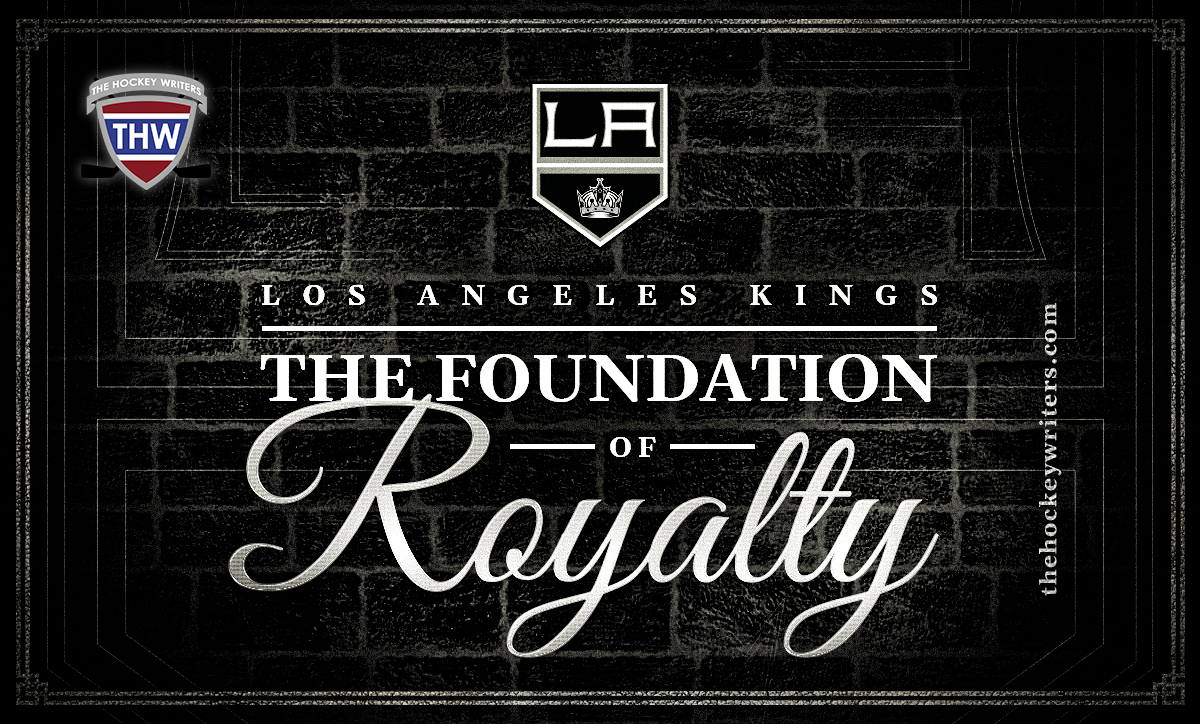
After much thought and consideration, it would be determined in early 1966 which cities would be awarded a new NHL team. Housed in a division of their own – the West Division – these “Second Six” teams would be the Minnesota North Stars, Oakland Seals, St. Louis Blues, Philadelphia Flyers, Pittsburgh Penguins, and the Los Angeles Kings. For the first time in league history, 12 teams would be competing for the Stanley Cup beginning with the 1967-68 season.
Hockey Comes to Paradise
This expansion would also mark the first time that NHL hockey would be featured in the state of California. Since that time, a total of four different teams have seen the sunshine of the “Golden State” – the most successful of which, and the longest lasting, has been the Los Angeles Kings.
Since their inception in 1967-68, the Kings have appeared in three Stanley Cup Finals, winning the championship in two of those appearances. It took 44 seasons for Los Angeles to win their first Cup, and the team has now been in existence for over half a century.
You may also like:
- Projected Lineups for the Kings vs Predators – 12/21/24
- LA Kings Game Notes: Annihilate Flyers With 7-3 Thumping
- Kings’ Anze Kopitar Shows No Signs of Aging in 7-3 Win vs. Flyers
- Projected Lineups for Kings vs Flyers – 12/19/24
- LA Kings Game Notes: Still Winless in OT With 3-2 Loss to Pittsburgh
Along the way, there have been numerous historical moments, colorful characters, and memories to last a lifetime.
THW takes a look back at the history of the Kings, from their earliest beginnings up to the present day. Many of the names we will mention are sure to invoke memories of your own, especially for those who have followed the Kings for a long time. We hope that you will enjoy this look back at one of hockey’s most fabled franchises.
The 1960s
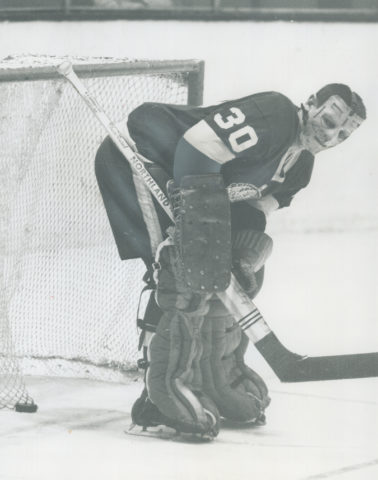
It was original owner Jack Kent Cooke who brought ice hockey to the beautiful beaches of southern California. Having already owned the Los Angeles Lakers of the National Basketball Association, Cooke’s new ownership of the Kings certainly made sense. He was a Canadian from Hamilton, Ontario, and while his earliest sports ownership was with the Lakers and the NFL’s Washington Redskins, Cooke’s truest passion was for hockey.
Cooke named the team the “Kings” because he wanted to bring forth an air of royalty. On October 14, 1967, the Kings played and won their first game at the Long Beach Arena against the Philadelphia Flyers, 4-2. Cooke had quite a reputation in Hollywood, as he fully intended to glamorize and brand his new team.
The most renowned original King was none other than 38-year-old legendary goaltender Terry Sawchuk. Many still consider Sawchuk the greatest goalie ever to play the game. By the time he was claimed by the Kings from Toronto in the 1967 Expansion Draft, Sawchuk had already won four Stanley Cups and had earned 100 shutouts in his career. He would earn a record of 11-14-6 with the first-year Kings, and added another two shutouts to his incredible career total.
Aside from Sawchuk however, those early Kings teams did not really have much in the way of “big names”. Cooke, who had a penchant for nicknames and a desire to glitz-up his new hockey club, peddled the more colorful names of his players to further ingratiate them among “Tinseltown”.
In the earliest seasons of the franchise came the likes of Eddie “The Jet” Joyal, Eddie “The Entertainer” Shack, “Cowboy” Bill Flett, Juha “Whitey” Widing and Real “Frenchy” Lemieux to name a few. Finally, Cooke would change the course of Kings’ history by building the Forum, or better known to Hollywood locals as “The Fabulous Forum,” where the team would play for the next 32 seasons.
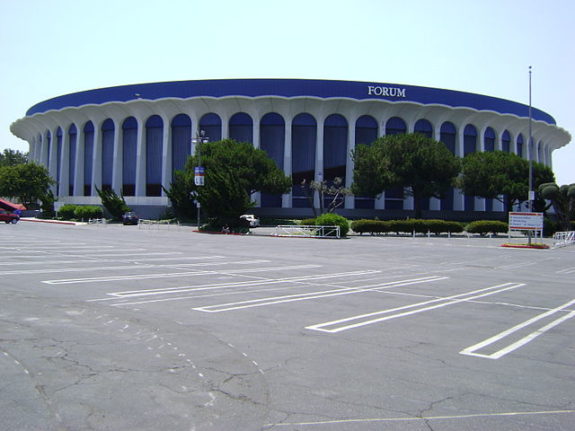
The Kings went on to finish their first season 31-33-10 – one of the better records ever completed by an NHL expansion team. The decades to come would bring many more stories of royal success to California as the Kings continued on their journey.
The 1970s
The 1970s began with the Kings acquiring future Hall of Famer Bob Pulford from the Toronto Maple Leafs, in exchange for Garry Monahan and Brian Murphy on Sept. 3, 1970. A seasoned veteran, Pulford not only brought proven leadership to the Kings’ locker room but also infused a sense of legitimacy and respect into the team’s lineup.
Pulford, a left winger, had won four Stanley Cups as a member of the Leafs prior to the trade. He would finish his NHL playing career with the Kings, with his final two campaigns in 1970-71 and 1971-72.
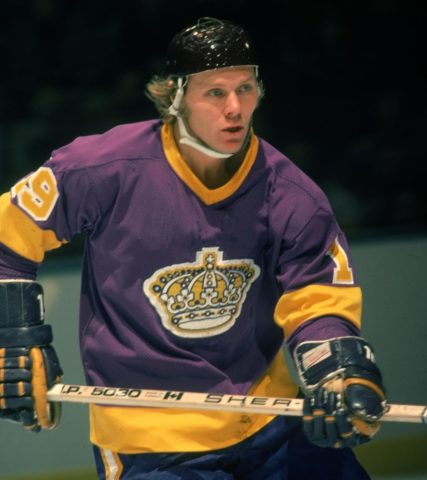
Retiring as a player, Pulford became head coach for Los Angeles in 1972-73 and would proceed to lead them to four straight playoff appearances after his first season as coach.
With Pulford at the helm, the Kings posted a team-best 42-17-21 record in 1974-75. Much of that success can be attributed to the incredible goaltending of Hall of Famer Rogatien Vachon, as well as the intense checking of players such as Butch Goring, Mike Murphy and Bob Nevin.
On Jun. 23, 1975, the Kings made what would be one of their most significant trades in franchise history. Sending Terry Harper, Dan Maloney and a 1976 second-round draft pick to the Detroit Red Wings, Los Angeles would receive superstar Marcel Dionne and defender Bart Crashley.
While Crashley would play all of four games in a Kings’ uniform, the Hall of Famer Dionne would play just short of 12 seasons for the franchise. He would become the first King to score 50 goals in an NHL season – something he would accomplish six times for them. Of the 731 goals that Dionne scored in his NHL career, 550 of them were scored while with Los Angeles.
As the decade came to a close, Cooke would sell the Kings, Lakers, and “The Fabulous Forum” to Dr. Jerry Buss in 1979.
The 1980s
The beginning of the 1980s would feature a trio in Los Angeles that is still considered one of the premier forward lines in hockey history. Dionne would be joined by right-winger Dave Taylor and left-winger Charlie Simmer to form “The Triple Crown” line. In the 1979-80 season alone, they combined for 328 points as a unit. The very next season they became the first line combination where each member surpassed 100 points in a single season (Dionne – 58-77-135, Taylor – 47-65-112, Simmer – 56-49-105).
As the decade went along, the Kings brought in a host of young talent that became the makeup of the team. Players such as Bernie Nicholls, Larry Murphy, Jim Fox, Mark Hardy, Jay Wells, Steve Bozek, Doug Smith, Brian MacLellan, Grant Ledyard and Garry Galley were among the fan favorites for the better part of the decade.
Many of those same players were part of the incredible come-from-behind overtime playoff thriller against the Edmonton Oilers in 1982, in what became called “The Miracle on Manchester”.
Related: 1982 – The Miracle on Manchester
Reaching the middle part of the decade, three talented Kings youngsters came aboard. Luc Robitaille, Jimmy Carson, and Steve Duchesne represented L.A. on the NHL’s All-Rookie Team for 1986-87. Robitaille, who would become a Stanley Cup-winner late in his career with Detroit and would be inducted into the Hockey Hall of Fame, is still considered by many to be the all-time greatest Kings player. Duchesne won a Cup at the end of his career too playing again alongside Robitaille, while Carson became the second-youngest player in NHL history to score 50 goals in a season.
The Dionne era in Los Angeles ended when the Kings traded the center to the New York Rangers on March 10, 1987. He would ultimately receive induction into the Hockey Hall of Fame in 1992, while the Kings retired his number-16 jersey in 1990.
The biggest moment of the 1980s, however, was Los Angeles’ acquisition of “The Great One”, Wayne Gretzky in August of 1988. With Bruce McNall having obtained majority ownership of the team in 1987, he stunned the hockey world on Aug. 9, 1988 when he traded Carson, Martin Gelinas, and first-round draft picks in 1989, 1991 and 1993, and cash to the Edmonton Oilers in exchange for Gretzky, Mike Krushelnyski and Marty McSorley.
The future of the Kings would forever be changed when hockey’s greatest player arrived in town, making Los Angeles an ideal player destination ever since.
Gretzky set a team record with 168 points (54 goals, 114 assists) during the 1988-89 season – his first with the Kings. With number-99 leading the charge, the team would make the playoffs in each of his first five seasons in Los Angeles.
The 1990s
This decade brought the Kings their first-ever Stanley Cup Final appearance. For the 1992-93 season, rookie head coach Barry Melrose guided an underdog team (39-35-10 for 88 points in the Smythe Division) into a showdown against the Montreal Canadiens. Despite a tremendous performance by Gretzky (15-25-40 in 24 games), the Kings would lose in five games to the Canadiens, as Montreal won their 24th Stanley Cup.
The remainder of the decade would be disappointing for L.A.. The Kings failed to make the playoffs in 1993-94, 1994-95, 1995-96, 1996-97 and 1998-99. Subsequently, the team changed owners out of bankruptcy, placing the title in the hands of Philip F. Anschutz and Edward P. Roski, Jr. They would enter into a rebuilding phase, with their first move being the appointing of legendary Kings player Dave Taylor to the position of General Manager.
Additionally, the STAPLES Center arena was officially opened on Oct. 17, 1999, and became the new home for the Kings.
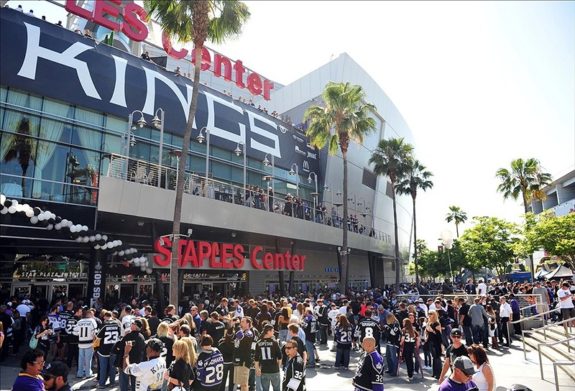
The team also acquired a new $24 million training facility (Toyota Sports Center) in El Segundo, California. While the latter half of the decade’s play on the ice was less than desirable, the building transitions were a sign of better days to come.
The 2000s
The Kings would make three consecutive playoff appearances from 1999-00 through 2001-02 under the tutelage of new head coach Andy Murray. The team was also revamped in terms of player personnel. Captain and one of the best defensemen in the league, Rob Blake, would be traded to the Colorado Avalanche where he would win a Cup of his own. Meanwhile, players such as Ziggy Palffy, Lubomir Visnovsky, and Mattias Norstrom became household names for the Kings.
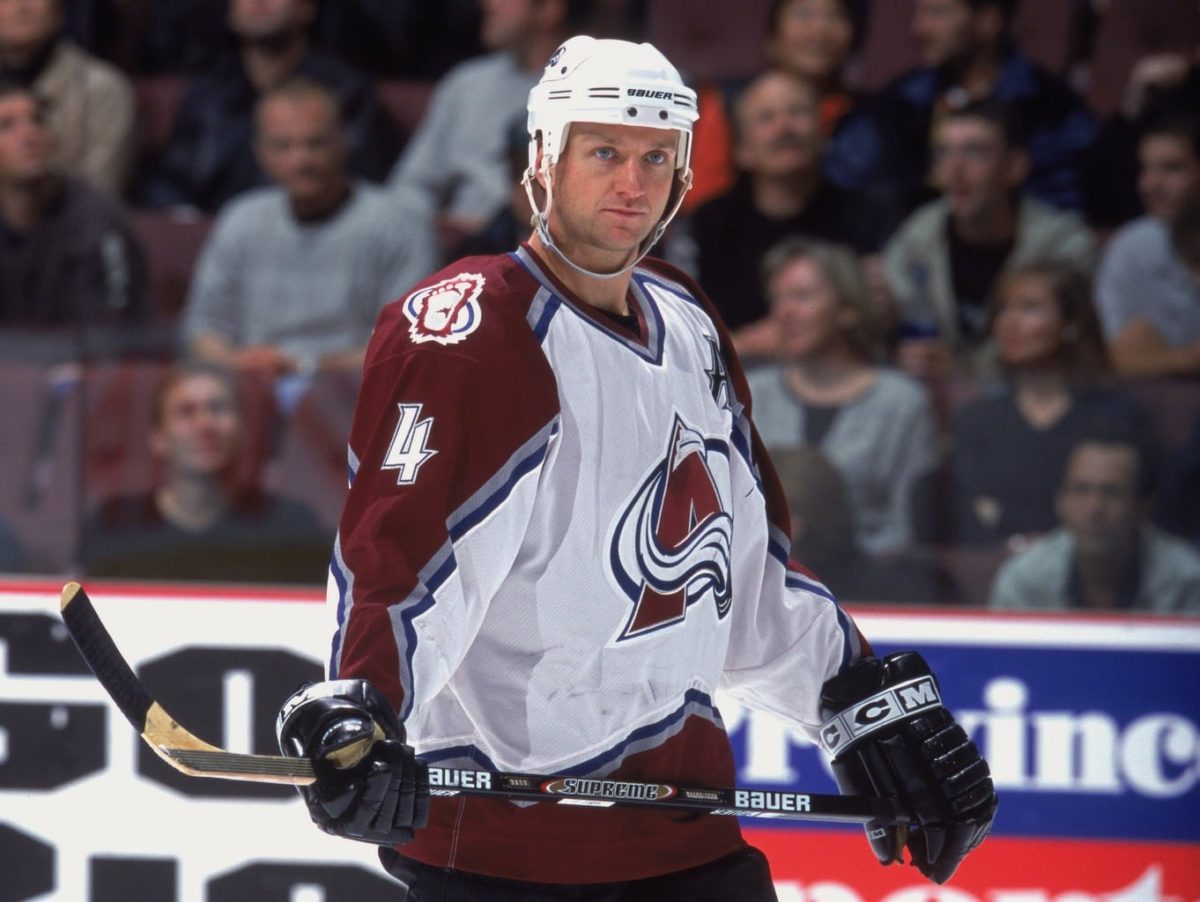
Unfortunately, despite the early success that Murray’s teams initially found, the Kings would see a woeful remainder of the decade. Following an opening-round playoff loss in 2001-02, Los Angeles would fail to make the playoffs for the next six seasons – their longest playoff drought in franchise history.
The postseason misses saw a revolving door of coaches – Andy Murray, John Torchetti, Marc Crawford and Terry Murray. There would also be a revolving door of players too. Expected Los Angeles stars like Martin Straka, Jozef Stumpel, Pavol Demitra, Jeremy Roenick, and Kyle Calder all came and went with little to no success.
While on-ice results were discouraging, it was the off-ice work of the Kings’ front office and scouting staff that would pave the way for a better future. Dean Lombardi would be named the team’s general manager in April 2006.
A shrewd developer of talent and a keen eye for top-notch prospects, Lombardi was able to stack his team for the future with a slew of acquisitions. Players such as Alec Martinez, Wayne Simmonds, Slava Voynov, Jordan Nolan, Kyle Clifford, Jonathan Bernier, and perhaps most importantly, Drew Doughty were all drafted by the Kings under Lombardi’s watch before the decade came to a close.
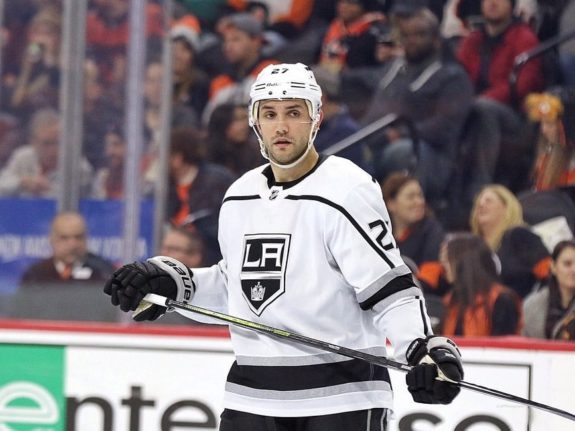
Blessed with already having drafted future stars such as goaltender Jonathan Quick and forward Anze Kopitar the year prior to Lombardi’s appointment, the Kings were primed for eventual Stanley Cup success.
The 2010s
The 2010s would see the many years of highs and lows finally culminate into a Cup-winning team for Los Angeles. Not only did the Kings finally – and truly – put a non-traditional hockey market like California onto the map, but they became one of the more successful franchises of the decade.
They first caught fire at the end of the 2011-12 season, when they went on a tear of 12–4–3 in the final 19 games of the regular season to squeak into the playoffs. The Kings secured the eighth and final playoff spot in their second-to-last game of the season.
Once the playoffs got underway, the upstart Kings would dispel the Vancouver Canucks (4-1), St. Louis Blues (4-0), and Phoenix Coyotes (4-1) to make it to their second Stanley Cup Final. Los Angeles was fueled by the brilliant goaltending of Quick, and the postseason scoring punch of Kopitar, Doughty, Justin Williams, team captain Dustin Brown, Mike Richards, Jeff Carter, and Dustin Penner, who each reached double digits in playoff scoring that season.
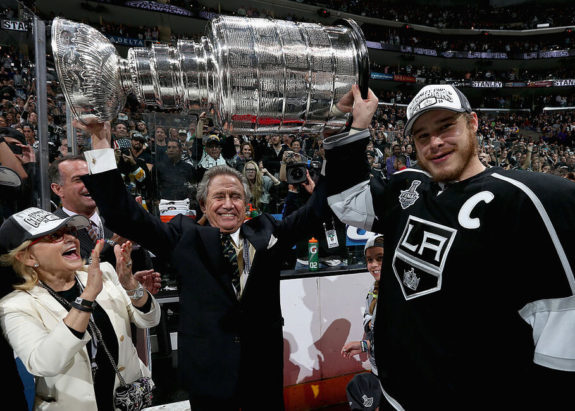
Defeating the New Jersey Devils four games to two – including Game One and Game Two overtime wins – the Kings would win the first championship in the club’s history. Much of that achievement has to be attributed to the play of Quick, who would receive the Conn Smythe Trophy as the playoff MVP.
The Kings were far from being a “one-trick pony”. They would repeat the feat of becoming Stanley Cup winners just two seasons later in 2013-14. Worth noting too that they nearly defended their title in 2012-13 by making it all the way to the semi-finals, before barely losing to the Chicago Blackhawks in overtime of Game Five.
While the secondary run ultimately fell short, Los Angeles would nonetheless be at the top of the mountain once more in the following season. Having much of the same composition as the 2011-12 squad, the Kings enlisted newcomers like Marian Gaborik, Robyn Regehr, Tanner Pearson, and Tyler Toffoli to secure their second Cup victory. They did so off of a solid 46-28-2-6 regular-season record.
It would take Los Angeles three consecutive 7-game series to eliminate the San Jose Sharks, Anaheim Ducks, and Blackhawks in order to get themselves back into the Final. Once there, the Kings needed just five games to topple the Rangers and reacquire the Cup. This time around it would be veteran Justin Williams who would be the Conn Smythe recipient after he went 9-16-25 in scoring through 26 postseason games.
The second half of the 2010s ended up being more lackluster for the Kings. They missed the playoffs in 2014-15, 2016-17 and 2018-19, while suffering opening round losses during the appearances in between.
That being said, their most key players continued to produce and are still among the best in the NHL. Kopitar remains as one of the premier two-way players in the game today, and has won the Selke Trophy as the top defensively-minded forward in the game in both 2015-16 and 2017-18. Doughty earned himself a Norris Trophy in 2015-16. Meanwhile, Quick nabbed 2017-18’s William M. Jennings Trophy as the goalie with the fewest goals against.
At the beginning of the 2019-20 NHL season, nine players remained on the Kings’ roster from the 2013-14 Cup victory. Now into the 2020s and with Los Angeles have obtained a status as a very viable, historic franchise, we are certain that Jack Kent Cooke is somewhere smiling very proudly upon the team that he once founded. Here is to another 50 years of Kings hockey!
